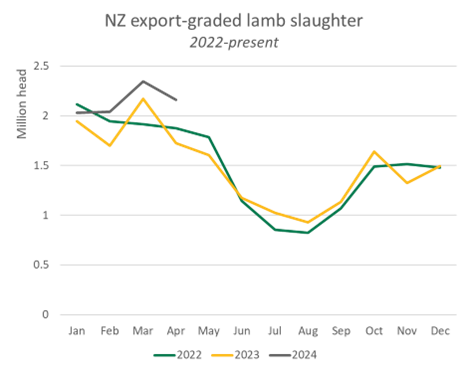Kiwi sheepmeat supply makes room for Aussie lamb
27 June 2024
Key points:
- New Zealand (NZ) is the second-largest lamb and mutton exporter globally.
- Rainfall on NZ’s North Island has improved on-farm conditions.
- NZ export volumes are likely to moderate from current highs.
Australian lamb slaughter reached a new peak last week, with the National Livestock Reporting Service (NLRS) slaughter report recording over 510,000 head. This figure is in line with the high production we’ve seen over the past few years; 2023 saw the largest lamb production volume on record, and Australian sheepmeat made up half of all exports.
This means there was more lamb and mutton available in the global market last year than ever before, which has been compounded by a strong supply from New Zealand, the second largest exporter, making up roughly 30% of global supply.
While NZ supply has been strong so far this year, there are signs that production will soften over the coming months.
Slaughter

For the year-to-April, total NZ sheep and lamb slaughter lifted 8% year-on-year to just under 10 million head.
This increase in slaughter has manifested as a sharply higher stock turn-off rate, suggesting the flock will continue to shrink in the future.
The increase in total slaughter was entirely due to a 14% uptick in lamb slaughter, while sheep slaughter fell 19%. The high rate of lamb slaughter means the breeding ewe flock will shrink and that the future lamb crop is likely to be smaller, even if lambing percentages increase due to better conditions.
This increase in slaughter has begun to reverse, according to market reports in New Zealand. Commentary suggests that processors are beginning to face low supply, and deadweight lamb prices have begun to lift.
Weather
Rain in key areas has improved the seasonal outlook for the rest of the year. This is especially true of the North Island, which had the largest increases in slaughter, and endured a hot and dry summer. With that said, some parts of the South Island remain dry; mostly confined to the Canterbury plains north of Wellington.
Looking ahead
Increased slaughter and dry conditions have encouraged destocking, resulting in a reduction in the size of the flock. As both of these factors are beginning to reverse, it’s likely that NZ sheepmeat export volumes will begin to moderate over the next several months.
As the only major competitor to Australian sheepmeat in the global market, moderated supply of NZ sheepmeat will be a positive for Australia, freeing up space in the global market for the record production volumes Australia is forecast to export over the remainder of 2024.


